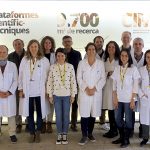
The Complex Diseases Genomics Group of the Sant Pau Hospital Research Institute – IIB Sant Pau, led by Dr. José Manuel Soria, demonstrates, for the first time, which epigenetic mechanisms are involved in the risk of suffering a thrombotic condition. This work, which will be published in the May issue of the prestigious scientific journal ATVB (Arteriosclerosis, Thrombosis and Vascular Biology), recognizes the group of Sant Pau scientists as world pioneers in establishing an epigenetic profile of thrombosis.
Link to the article
The study has specifically analysed microRNAs, elements responsible for regulating the expression of our genes under certain specific circumstances, and has made it possible to establish a profile of microRNA expression (biomarkers) as a risk factor for thrombosis. This allows us to establish a pattern that detects the genetic predisposition of a patient to develop thrombotic conditions.
The results of the work will improve the diagnosis, prevention and treatment of thrombosis, changing clinical practice, and therefore will have a high impact on the health of the population.
Only in Europe, every minute, a person dies from a thrombotic event
Currently, the Complex Disease Genomics research group is analyzing the impact that this microRNA profile has on the risk of thrombosis in cancer patients, since thromboembolic disease is the leading cause of death among cancer patients (about 20% of cancer patients will suffer a thrombotic event, depending on the type of tumor).
This microRNA profile will also play an important role in the project that the Sant Pau Research Group is designing to assess the risk of thrombosis in the COVID patient, who develops coagulation and thrombosis disorders, which is a serious clinical complication with a high mortality rate.
The team of scientists has developed the study at the Hospital de Sant Pau Research Institute – IIB Sant Pau, and it is led by the head of the Complex Diseases Genomics Group of the same institute, Dr. José Manuel Soria, who has coordinated Drs. Alba Rodríguez-Ríos, Sonia López, Angel Martínez-Pérez and Dr. Juan Carlos Souto, research member of the Hospital de la Santa Creu i Sant Pau and consultant to the Haemostasis Unit of the Haematology Service.
Association “ACTIVA’TT against thrombosis”
Doctors Soria and Souto are founding members of the association “ACTIVA’TT against thrombosis”, which works with the Sant Pau Research Institute and the Hospital de Sant Pau, to improve the diagnosis, prevention, treatment and social education towards these important pathologies.
www.activatt.com




















